SPAIN
2009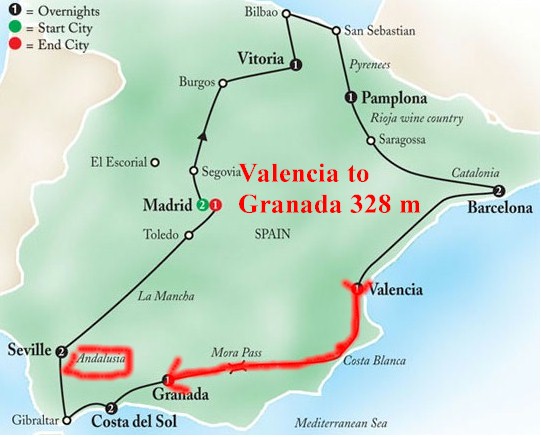
Day
9 May 18
Monday
VALENCIA
to GRANADA
We
had a good breakfast on the top of the hotel with a great view.
It was a nice buffet but there were no eggs or bacon.
They had to be a special order.
We
traveled about two and half hours before a break at an auto grill.
Around noon we stopped at another one for lunch.
We
are now in the southern region of Spain known as Andalusia. Andalucía
is composed of eight provinces, stretching from the south-east to the south-west
of the country, each one named for its capital city: Cadiz, Cordoba, Jaen,
Huelva, Almeria, Malaga, Granada and Seville.
Once
Spain’s poorest region, Andalucía is now one of the most popular tourist
destinatio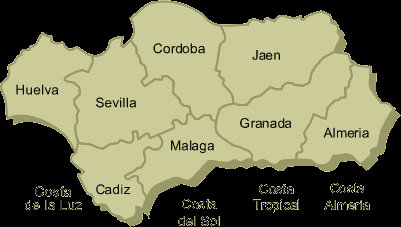 ns in Europe thanks to its sandy beaches, beautiful countryside,
spectacular mountain ranges, fabulous monuments and high-spirited people.
ns in Europe thanks to its sandy beaches, beautiful countryside,
spectacular mountain ranges, fabulous monuments and high-spirited people.
One
of the most unique features of Andalucía are the remnants of its Moorish past.
The Moors were a mixture of Berbers
and Arabs who crossed into Spain from North Africa by the Straits of Gibraltar
and occupied the peninsula – which they called al Andalus for
more than seven centuries dating from 710. Within
four years they had virtually conquered the entire country.
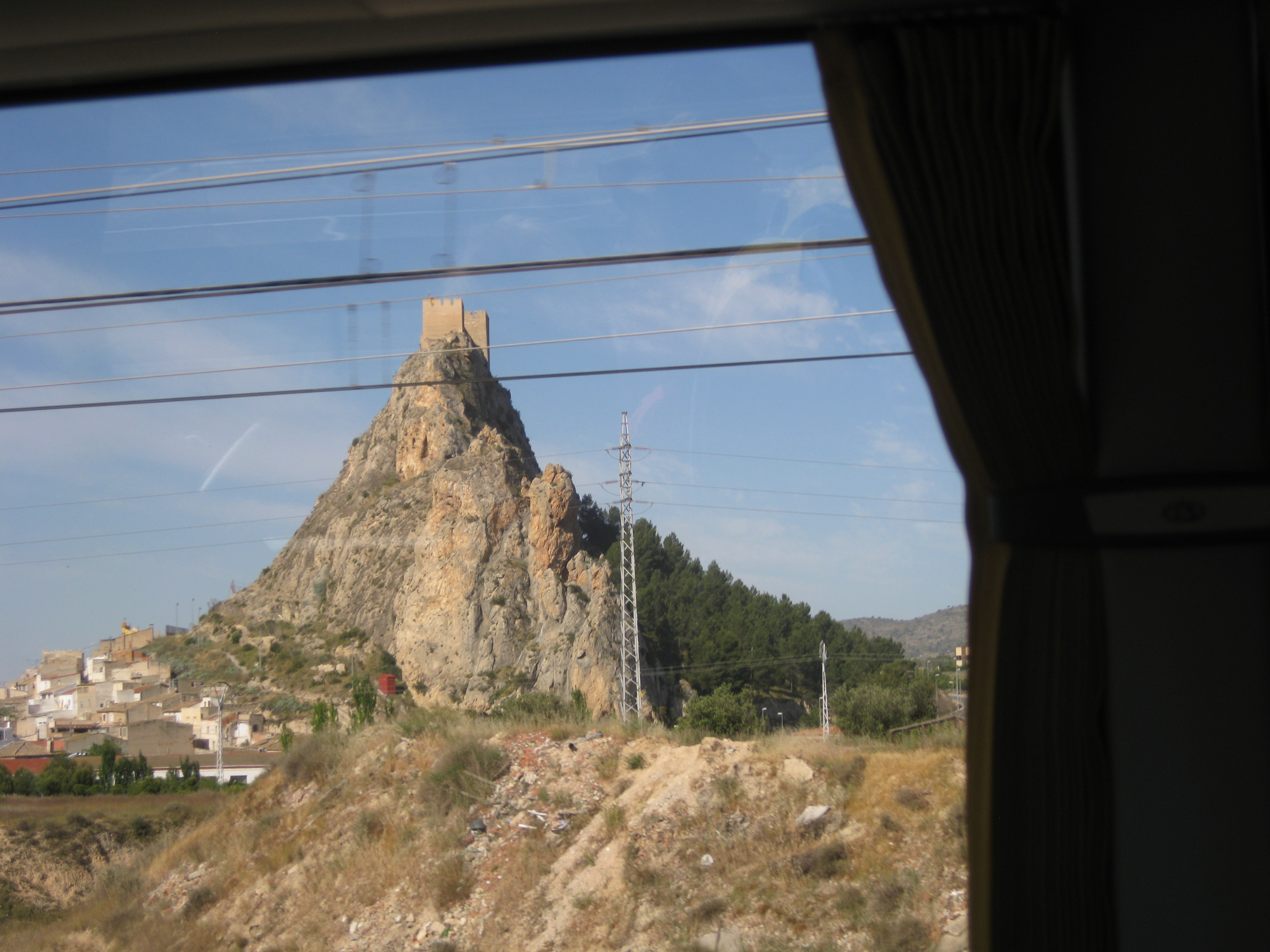 Córdoba
becomes the center and melting pot of different cultures and religions. Trade,
science, handicraft and arts grew and expanded. After the fall
of Córdoba (1236) and Seville (1248) the Nasrid Kings maintain their kingdom in
Granada for two and a half centuries more. The last Moor king, Boabdil,
surrenders the city of Granada to the Catholic Monarchs Isabel and Ferdinand in January
1492.
Córdoba
becomes the center and melting pot of different cultures and religions. Trade,
science, handicraft and arts grew and expanded. After the fall
of Córdoba (1236) and Seville (1248) the Nasrid Kings maintain their kingdom in
Granada for two and a half centuries more. The last Moor king, Boabdil,
surrenders the city of Granada to the Catholic Monarchs Isabel and Ferdinand in January
1492.
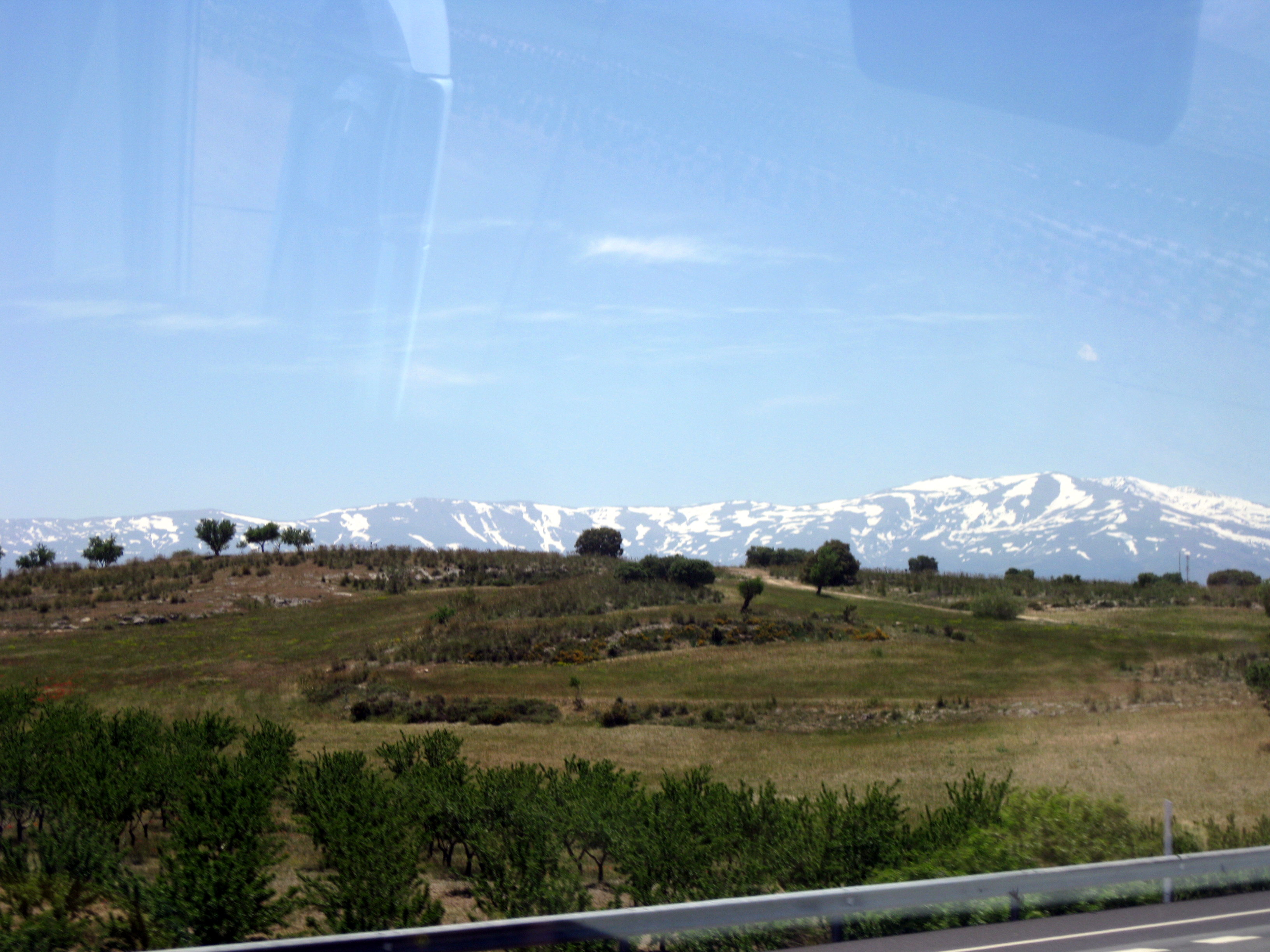
As
we neared Granada, we could see the snow on the Sierra Nevada mountain
range, until then the scenery had been rather monotonous.
Outside of Granada we saw the cave dwellers on the hillsides. People
still live in these caves.
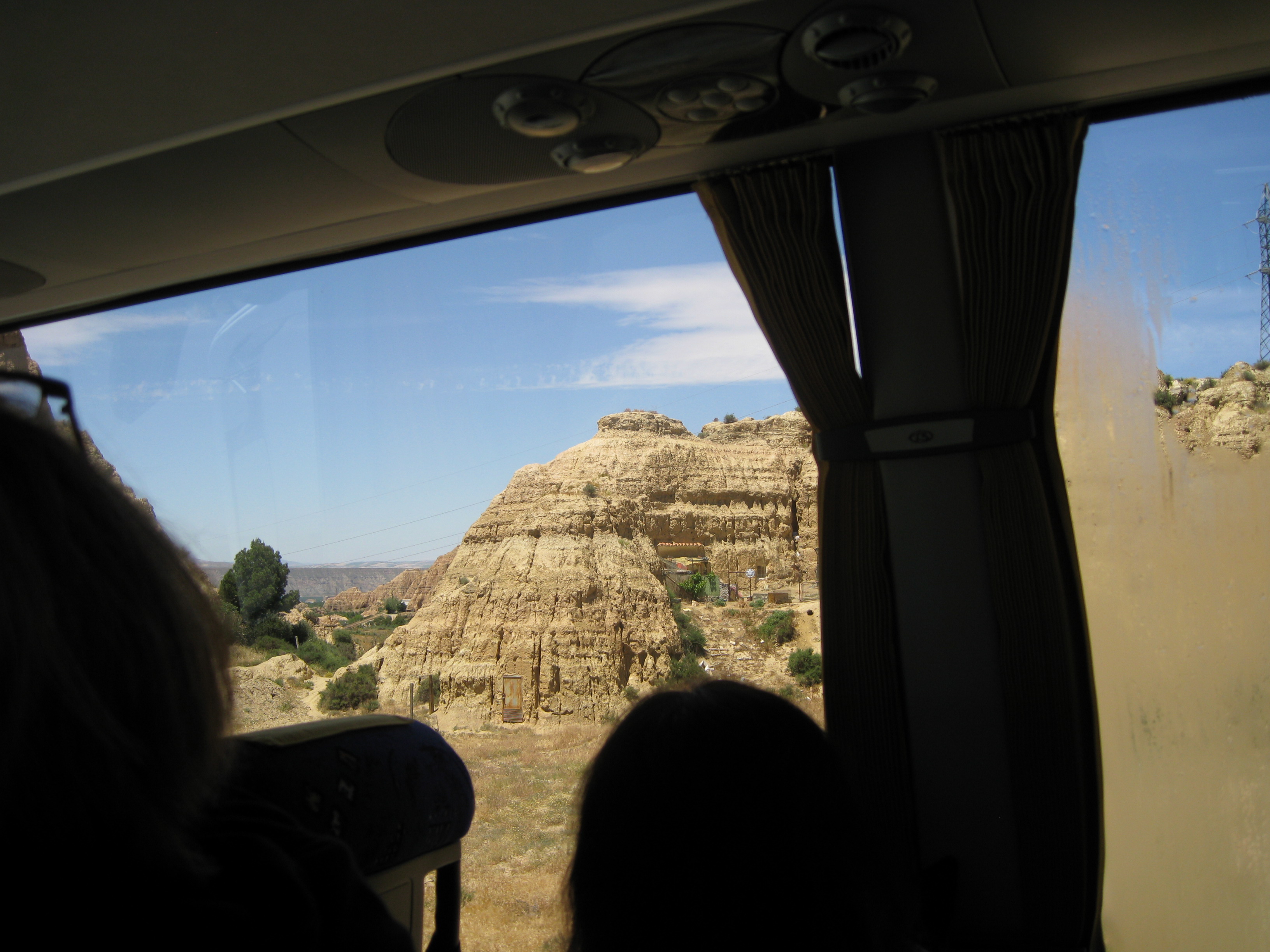
As
we drove into the city limits of Granada traffic came to a standstill in all
directions. Our bus driver
knew a lot of back streets through town and got us through.
We found out later that there had been a motorcycle accident.
A board had come off of a truck and struck the motorcycle driver and
killed him. They said traffic
was tired up for hours.
Granada
is about 2,200 ft. above sea level in the foothills of the Sierra Nevada. The
town sprawls over two main hills, the Alhambra and the Albaicín, and is crossed
by two rivers, the Genil and the Darro. This former stronghold of Moorish Spain
is full of romance and folklore.
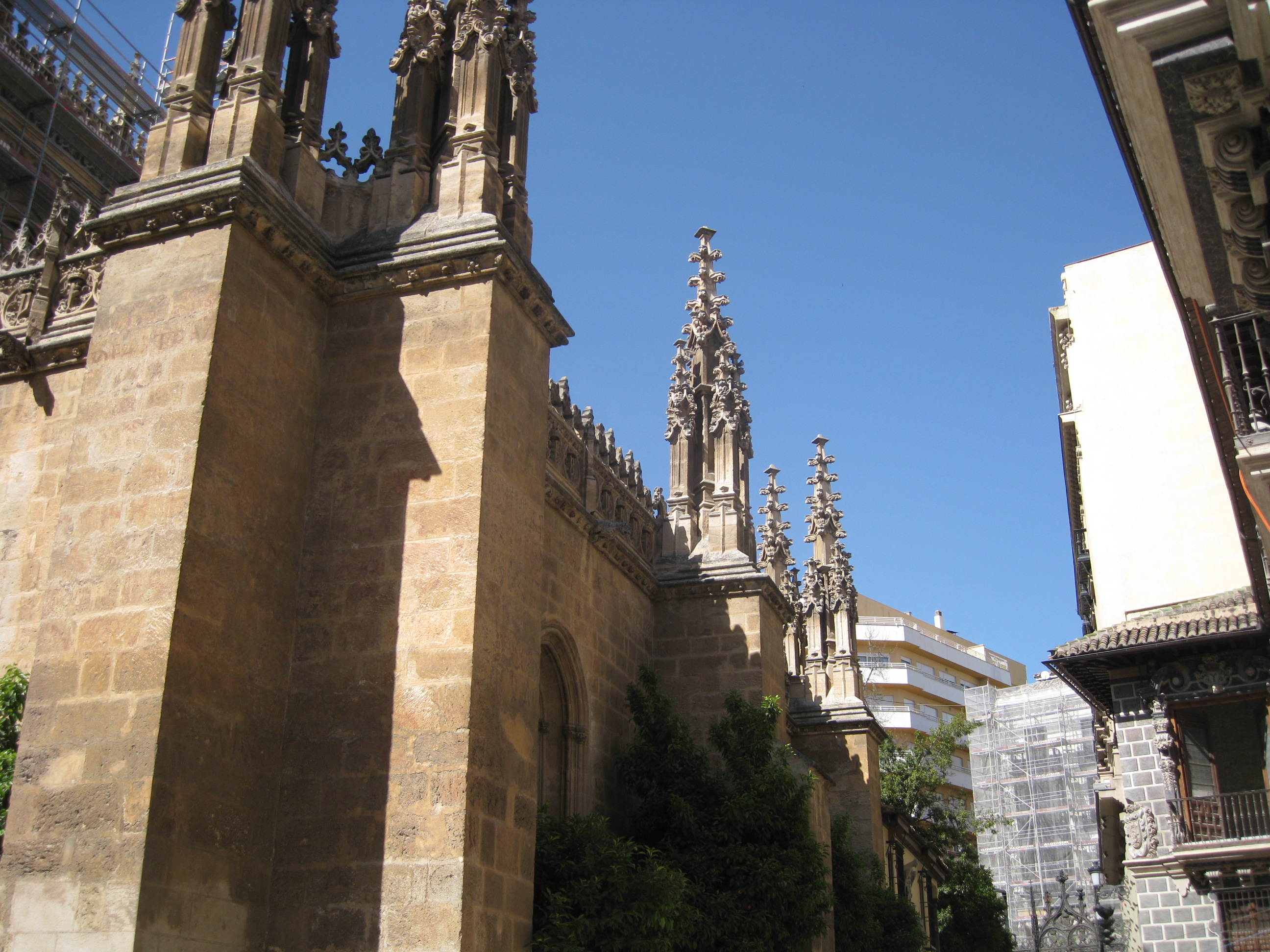
We
arrived at our hotel, Carmen, and checked in.
An optional tour was started immediately.
My wife choose not to go on it.
First it was a walking tour through an old part of town to the Royal Chapel
which is attached to the Cathedral. 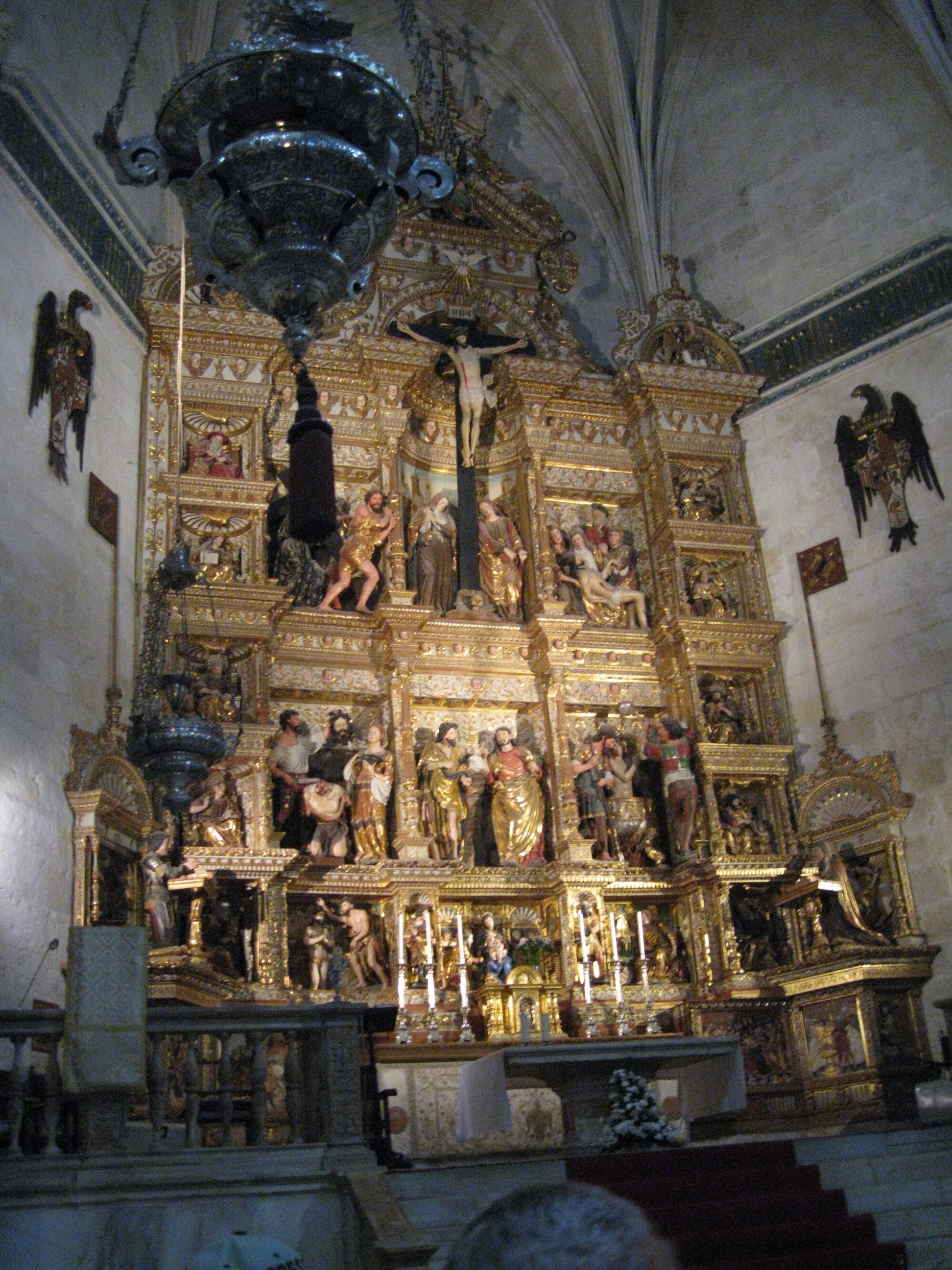
The
Royal Chapel has the tombs of Ferdinand and Isabella. It was their wish to be
buried in recaptured Granada. Occupying
much larger tombs are the remains of their daughter, Joanna the Mad, and her
husband, Philip the Handsome. The
architecture is flamboyant Gothic and Plateresque, which is a richly decorative
style of Spanish architecture of the 16th century; said to resemble the
intricate work of Spanish silversmiths in delicacy, hence its name (plata
is the Spanish word for silver). Work was begun by Enrique Egas in 1506 but not
completed until 1521 under the Emperor, Charles V.
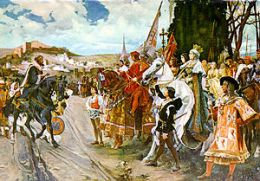 After
leaving the chapel we entered the sacristy where we viewed Isabella's personal art collection, including many works by Flemish masters and various
Spanish and Italian artists, including Rogier Van der Weyden and Botticelli. A
glass case contains Ferdinand of Aragón's sword, Isabella's scepter and crown.
Above the chapel's entrance doorway is a copy of the famous painting of
Boabdil's (the last Moorish King) surrender to Isabella. She is depicted wearing
her filigree crown. I was very disappointed that this tour did not take us into
the cathedral itself.
After
leaving the chapel we entered the sacristy where we viewed Isabella's personal art collection, including many works by Flemish masters and various
Spanish and Italian artists, including Rogier Van der Weyden and Botticelli. A
glass case contains Ferdinand of Aragón's sword, Isabella's scepter and crown.
Above the chapel's entrance doorway is a copy of the famous painting of
Boabdil's (the last Moorish King) surrender to Isabella. She is depicted wearing
her filigree crown. I was very disappointed that this tour did not take us into
the cathedral itself.
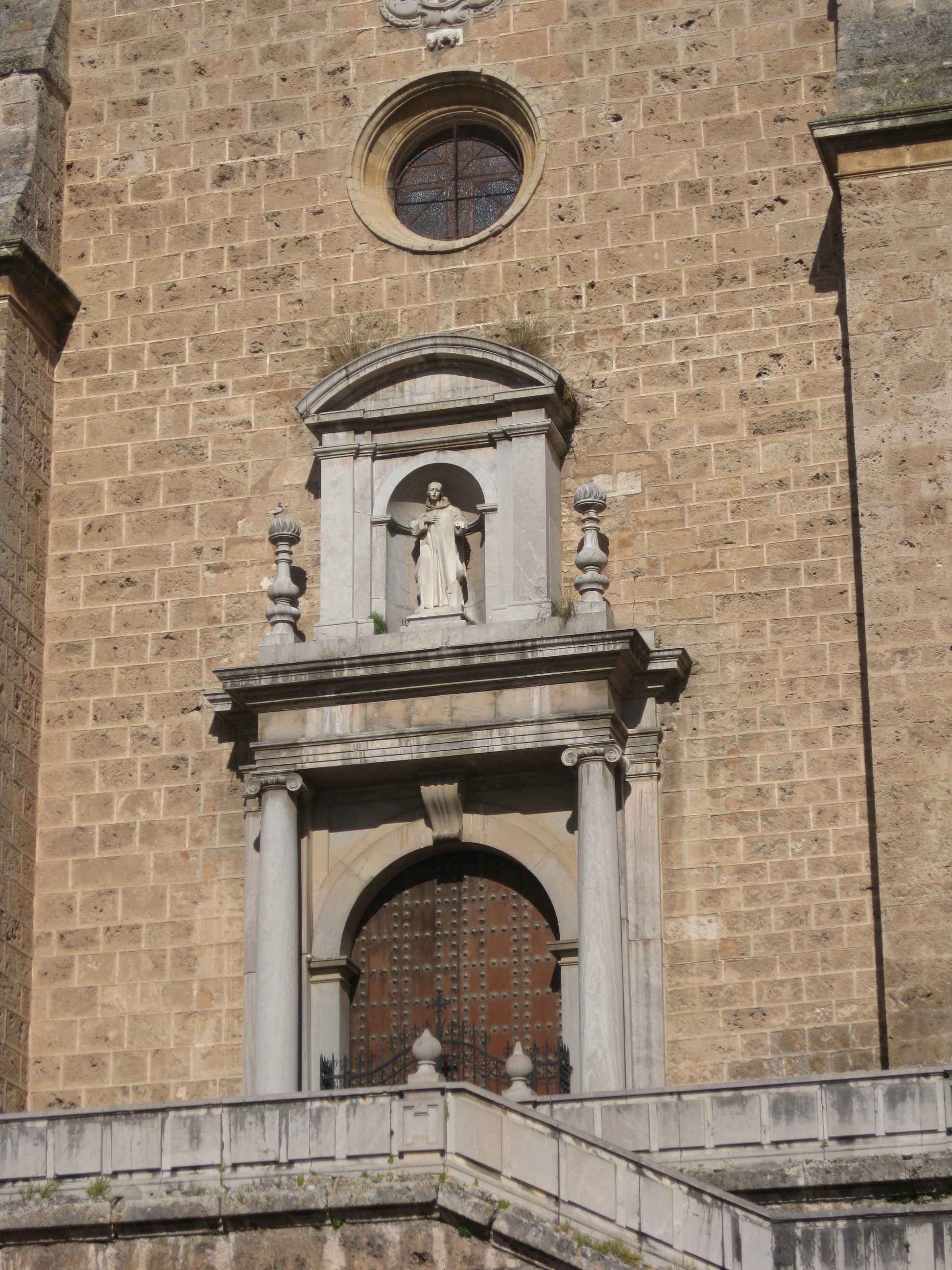 We
walked back to the hotel and got on the bus which took us up a high hill with a
great view of Granada and the Sierra Nevada range.
Our next stop was the Carthusian Monastery.
The bus dropped us off in a
small drive way. We had to climb a
number of steps to the main door. The
building appears small and the façade was rather plain.
There is a statue of St. Bruno, the founder of the Carthusian Order in
1027. This monastery was built on the grounds of an Arab recreational estate,
called Aynadamar or Source of Tears. In
the early 1500’s the Community of the Carthusian Order of El Paular made a
decision to build a new monastery but they did not find a specific site and so
they put it aside for a few years.
Later, Fr. Juan Padilla, prior of the monastery Cartuja de las Cuevas in
Seville turned to Don Gonzalo Fernandez de Cordoba (known as the Great Captain)
and his wife for help. He proposed
building the monastery on the grounds of the Aynadamar Estate.
He even offered to take charge of the project with the initial idea of
being buried in this new monastery. The
donation of this land was in 1513. Several
difficulties interrupted the work, among them the Great Captain’s death in
1515. Before he died, he had some
disagreements with the monks which made him change his mind about being buried
there. Work was resumed again in
1519 and in 1545 the Carthusian Monastery of Granada was incorporated into the
Order.
We
walked back to the hotel and got on the bus which took us up a high hill with a
great view of Granada and the Sierra Nevada range.
Our next stop was the Carthusian Monastery.
The bus dropped us off in a
small drive way. We had to climb a
number of steps to the main door. The
building appears small and the façade was rather plain.
There is a statue of St. Bruno, the founder of the Carthusian Order in
1027. This monastery was built on the grounds of an Arab recreational estate,
called Aynadamar or Source of Tears. In
the early 1500’s the Community of the Carthusian Order of El Paular made a
decision to build a new monastery but they did not find a specific site and so
they put it aside for a few years.
Later, Fr. Juan Padilla, prior of the monastery Cartuja de las Cuevas in
Seville turned to Don Gonzalo Fernandez de Cordoba (known as the Great Captain)
and his wife for help. He proposed
building the monastery on the grounds of the Aynadamar Estate.
He even offered to take charge of the project with the initial idea of
being buried in this new monastery. The
donation of this land was in 1513. Several
difficulties interrupted the work, among them the Great Captain’s death in
1515. Before he died, he had some
disagreements with the monks which made him change his mind about being buried
there. Work was resumed again in
1519 and in 1545 the Carthusian Monastery of Granada was incorporated into the
Order.
All
that is left of the entire monastery today are the Small Cloister, the Church,
the Tabernacle and the Sacristy. The
rest disappeared in 1842 with invasion of French troop and the Disentailment
(the expropriation of the property of religious orders by the state in 1837).
Presently the monastery does not belong to the Carthusian Order, but
depends directly on the Archbishopric and the Diocese of Granada.
The
inside the monastery is very different in its appearance from the outside.
We entered through a small cloister which contained orange trees, rose
bushes and aromatic plants with a fountain in the center.
It looked more like a Moorish courtyard than a typical monastery or
cathedral cloister.
The
first room that we entered was the refectory or dining hall.
Over the door was a painting of John the Baptist after his beheading with
his head on a platter. At the end
was a large painting of the Last Supper. It
was noted that there was a fish on Jesus’ plate instead of lamb as the
Carthusians didn’t eat meat. There
were a number of paintings around the room representing the persecutions and
executions of the monks in England by Henry VIII and the Huguenots in France.
These paintings are rather graphic.
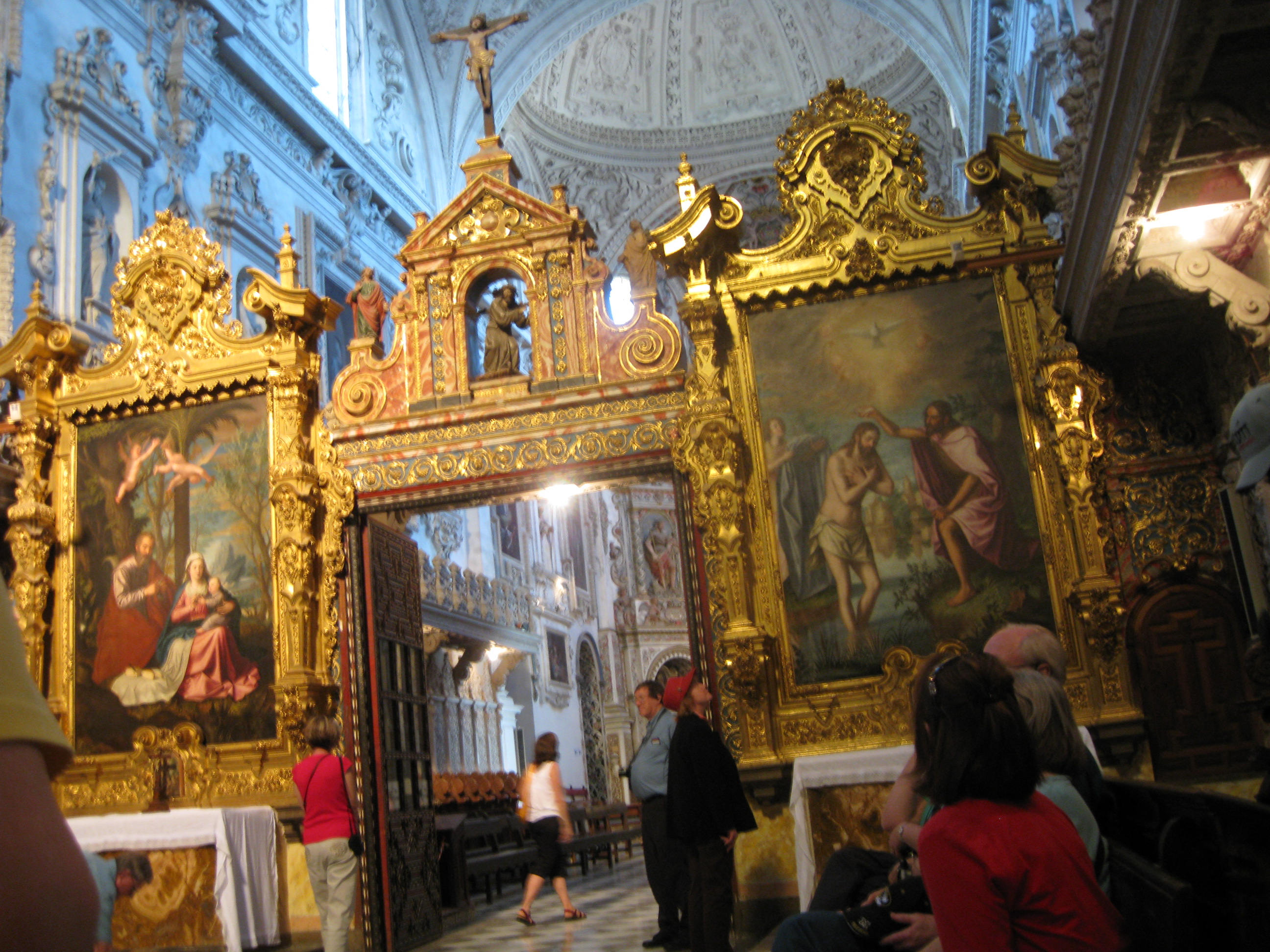 The
Baroque church dating from 1662 was very impressive.
There were three distinct sections. The
first, from the entrance to a gate, was for the faithful.
The second, from the gate to beautiful Marquetry door (1750), was for the
lay brothers. The third section is
for the monks. This section is totally cut off from the church.
The seats are so high that the monks couldn’t see each other.
There is no choir or orga
The
Baroque church dating from 1662 was very impressive.
There were three distinct sections. The
first, from the entrance to a gate, was for the faithful.
The second, from the gate to beautiful Marquetry door (1750), was for the
lay brothers. The third section is
for the monks. This section is totally cut off from the church.
The seats are so high that the monks couldn’t see each other.
There is no choir or orga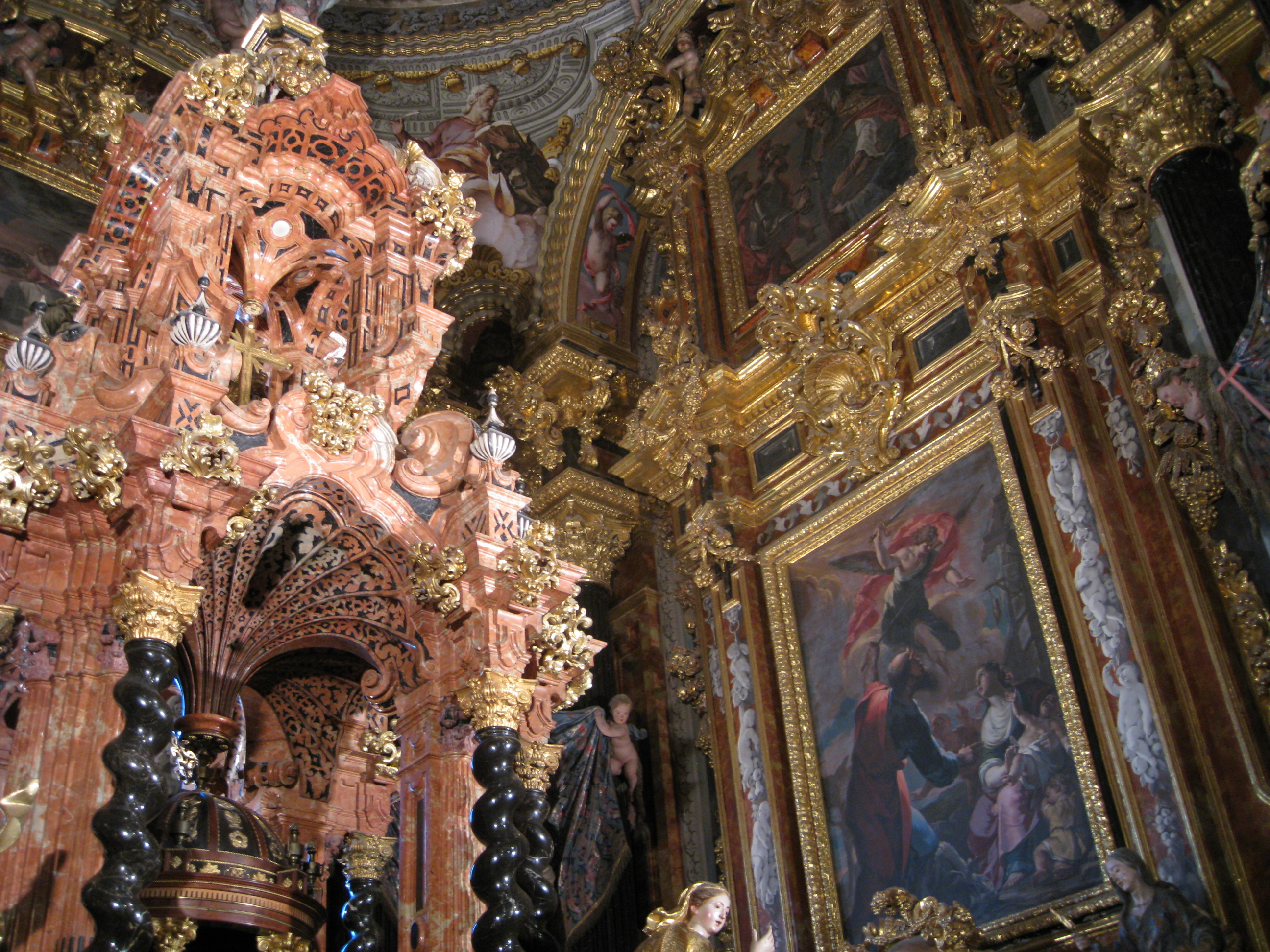 n as the Order forbid them.
n as the Order forbid them.
There
is also a b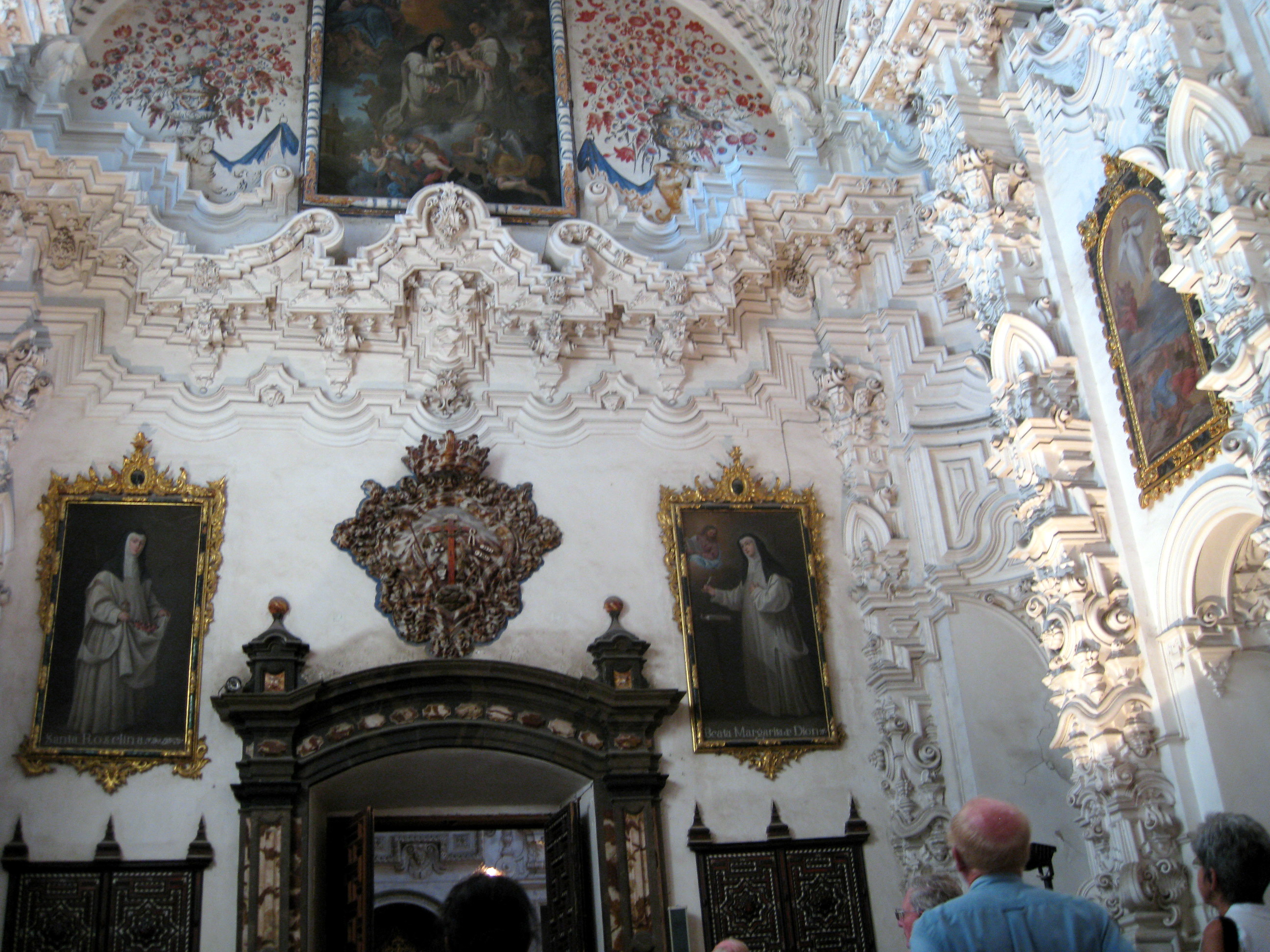 eautiful Sancta Sanctorium with a huge carved baldachin.
eautiful Sancta Sanctorium with a huge carved baldachin.
Also impressive was the Sacristy which was brilliant white marble in a
very baroque style. The entire visit
was very impressive. I am glad that
I went and sorry that my wife missed it.
My
wife took a half hour nap and then went off to the Royal Chapel and the
Cathedral on her own. She said that she was satisfied to be “in the presence
of Isabella, Ferdinand, Juana the Mad and Philip the handsome.
What amazing four people.” She
was accosted often by gypsies at the chapel and cathedral.
She found the cathedral was huge with wide aisles and huge pillars.
She also did some shopping on her venture. She was concerned about
finding her way back home. She got
back just a little after I did.
We
went to the bar for drinks. We
had some “crisps” (potato chips ). Several
of our group joined us. The buffet dinner was in the hotel.
There was a good selection of food, all very tasty. 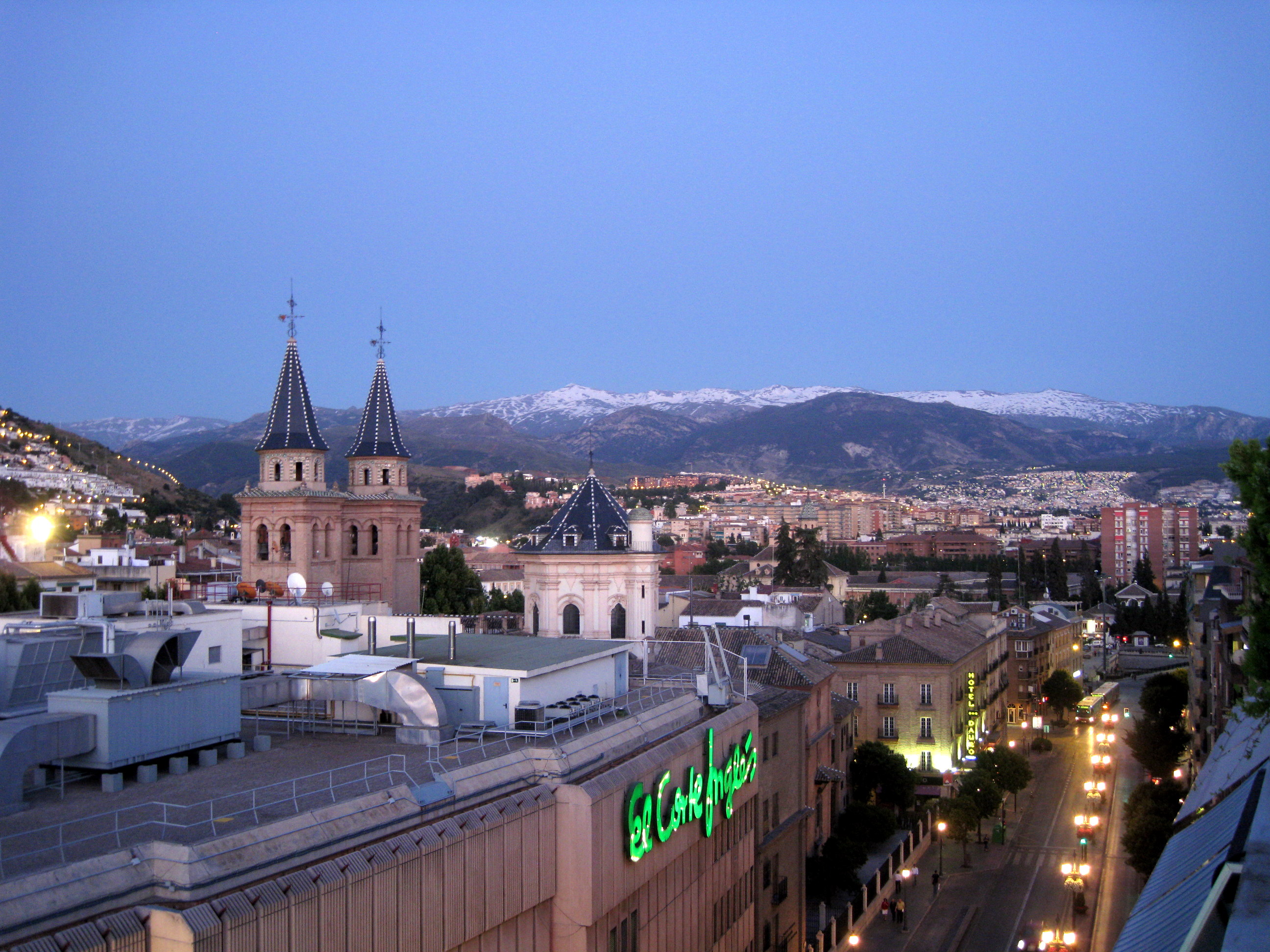
We were told that we
could go up on the roof to see the view. We
could see the Sierra Nevada with its snow. No
matter how spectacular the man-made buildings, the God-made snow made it all
fantastic.

 ns in Europe thanks to its sandy beaches, beautiful countryside,
spectacular mountain ranges, fabulous monuments and high-spirited people.
ns in Europe thanks to its sandy beaches, beautiful countryside,
spectacular mountain ranges, fabulous monuments and high-spirited people. Córdoba
becomes the center and melting pot of different cultures and religions. Trade,
science, handicraft and arts grew and expanded. After the fall
of Córdoba (1236) and Seville (1248) the Nasrid Kings maintain their kingdom in
Granada for two and a half centuries more. The last Moor king, Boabdil,
surrenders the city of Granada to the Catholic Monarchs Isabel and Ferdinand in January
1492.
Córdoba
becomes the center and melting pot of different cultures and religions. Trade,
science, handicraft and arts grew and expanded. After the fall
of Córdoba (1236) and Seville (1248) the Nasrid Kings maintain their kingdom in
Granada for two and a half centuries more. The last Moor king, Boabdil,
surrenders the city of Granada to the Catholic Monarchs Isabel and Ferdinand in January
1492. 



 After
leaving the chapel we entered the sacristy where we viewed Isabella's personal art collection, including many works by Flemish masters and various
Spanish and Italian artists, including Rogier Van der Weyden and Botticelli. A
glass case contains Ferdinand of Aragón's sword, Isabella's scepter and crown.
Above the chapel's entrance doorway is a copy of the famous painting of
Boabdil's (the last Moorish King) surrender to Isabella. She is depicted wearing
her filigree crown. I was very disappointed that this tour did not take us into
the cathedral itself.
After
leaving the chapel we entered the sacristy where we viewed Isabella's personal art collection, including many works by Flemish masters and various
Spanish and Italian artists, including Rogier Van der Weyden and Botticelli. A
glass case contains Ferdinand of Aragón's sword, Isabella's scepter and crown.
Above the chapel's entrance doorway is a copy of the famous painting of
Boabdil's (the last Moorish King) surrender to Isabella. She is depicted wearing
her filigree crown. I was very disappointed that this tour did not take us into
the cathedral itself. We
walked back to the hotel and got on the bus which took us up a high hill with a
great view of Granada and the Sierra Nevada range.
Our next stop was the Carthusian Monastery.
The bus dropped us off in a
small drive way. We had to climb a
number of steps to the main door. The
building appears small and the façade was rather plain.
There is a statue of St. Bruno, the founder of the Carthusian Order in
1027. This monastery was built on the grounds of an Arab recreational estate,
called Aynadamar or Source of Tears. In
the early 1500’s the Community of the Carthusian Order of El Paular made a
decision to build a new monastery but they did not find a specific site and so
they put it aside for a few years.
Later, Fr. Juan Padilla, prior of the monastery Cartuja de las Cuevas in
Seville turned to Don Gonzalo Fernandez de Cordoba (known as the Great Captain)
and his wife for help. He proposed
building the monastery on the grounds of the Aynadamar Estate.
He even offered to take charge of the project with the initial idea of
being buried in this new monastery. The
donation of this land was in 1513. Several
difficulties interrupted the work, among them the Great Captain’s death in
1515. Before he died, he had some
disagreements with the monks which made him change his mind about being buried
there. Work was resumed again in
1519 and in 1545 the Carthusian Monastery of Granada was incorporated into the
Order.
We
walked back to the hotel and got on the bus which took us up a high hill with a
great view of Granada and the Sierra Nevada range.
Our next stop was the Carthusian Monastery.
The bus dropped us off in a
small drive way. We had to climb a
number of steps to the main door. The
building appears small and the façade was rather plain.
There is a statue of St. Bruno, the founder of the Carthusian Order in
1027. This monastery was built on the grounds of an Arab recreational estate,
called Aynadamar or Source of Tears. In
the early 1500’s the Community of the Carthusian Order of El Paular made a
decision to build a new monastery but they did not find a specific site and so
they put it aside for a few years.
Later, Fr. Juan Padilla, prior of the monastery Cartuja de las Cuevas in
Seville turned to Don Gonzalo Fernandez de Cordoba (known as the Great Captain)
and his wife for help. He proposed
building the monastery on the grounds of the Aynadamar Estate.
He even offered to take charge of the project with the initial idea of
being buried in this new monastery. The
donation of this land was in 1513. Several
difficulties interrupted the work, among them the Great Captain’s death in
1515. Before he died, he had some
disagreements with the monks which made him change his mind about being buried
there. Work was resumed again in
1519 and in 1545 the Carthusian Monastery of Granada was incorporated into the
Order. The
Baroque church dating from 1662 was very impressive.
There were three distinct sections. The
first, from the entrance to a gate, was for the faithful.
The second, from the gate to beautiful Marquetry door (1750), was for the
lay brothers. The third section is
for the monks. This section is totally cut off from the church.
The seats are so high that the monks couldn’t see each other.
There is no choir or orga
The
Baroque church dating from 1662 was very impressive.
There were three distinct sections. The
first, from the entrance to a gate, was for the faithful.
The second, from the gate to beautiful Marquetry door (1750), was for the
lay brothers. The third section is
for the monks. This section is totally cut off from the church.
The seats are so high that the monks couldn’t see each other.
There is no choir or orga n as the Order forbid them.
n as the Order forbid them.
 eautiful Sancta Sanctorium with a huge carved baldachin.
eautiful Sancta Sanctorium with a huge carved baldachin.


